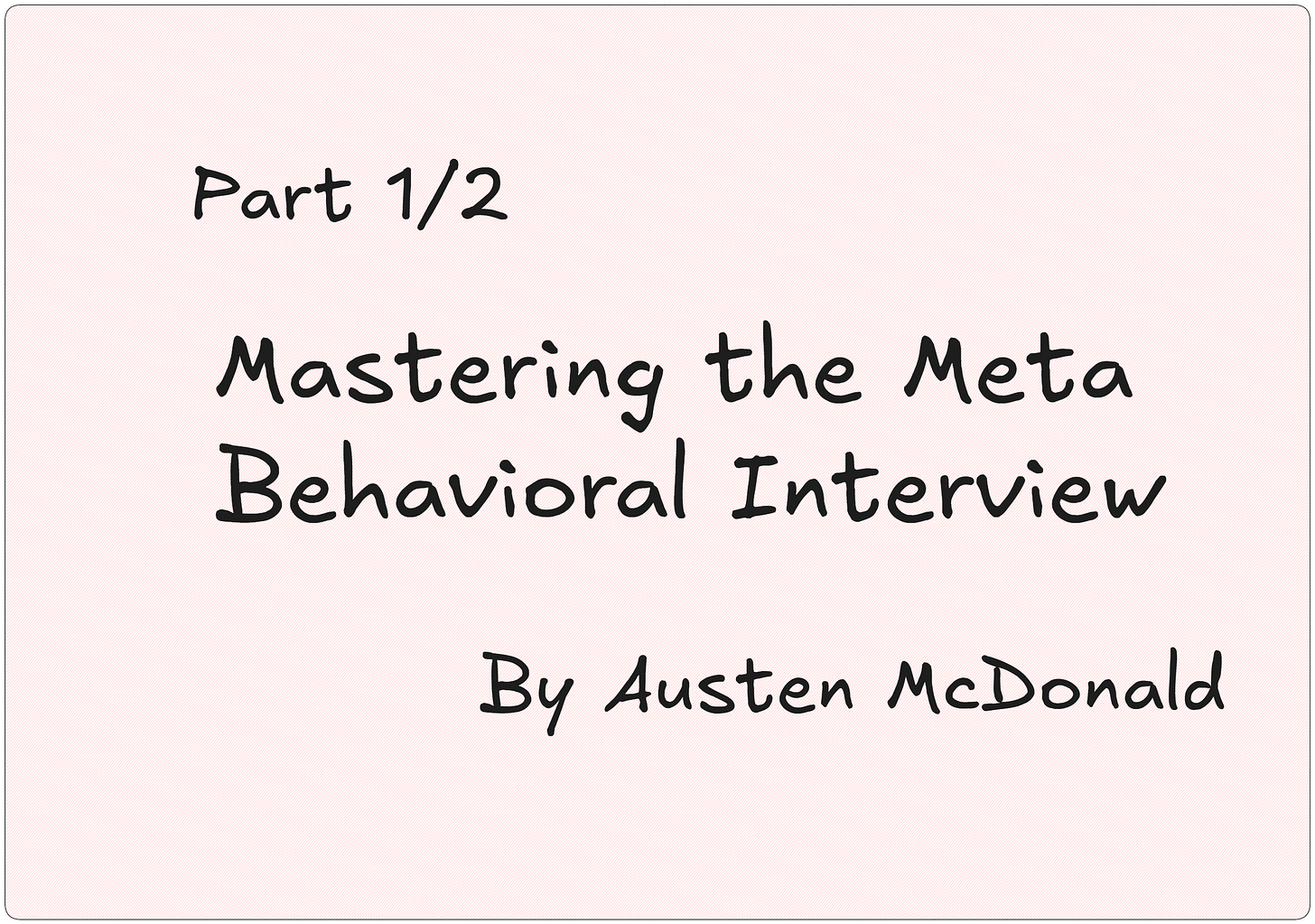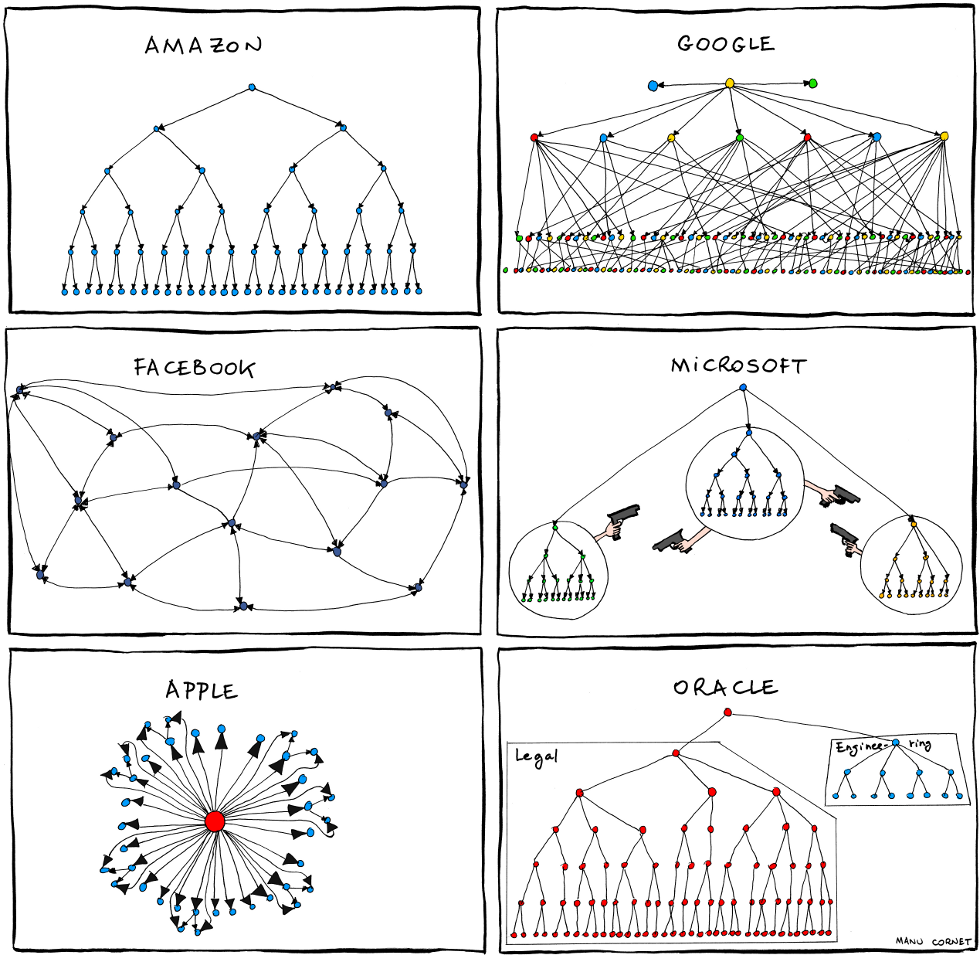Part 1/2 - Mastering the Meta Behavioral Interview
Engineering Culture and Leveling at Meta
Hey, Prasad here 👋 I'm the voice behind the weekly newsletter "Big Tech Careers."
This week I bring you a guest post from Austen McDonald, a former Senior Engineering Manager and Hiring Committee Chair at Meta and now the author of the Mastering the Behavioral Interview newsletter.
With over 1,000 big tech interviews conducted and 200+ behavioral interview mentees, he’s truly earned his LinkedIn tagline, “Behavioral Interview Enthusiast.” If you have a Meta interview loop coming up, this is an invaluable resource on how best to prepare.
If you like the article, click the ❤️ icon. That helps me know you enjoy reading my content.
Over to you, Austen!
What is the right amount of caffeination before a big tech onsite? I’ve read 100s of articles and books on tech interviewing and I’ve never heard that discussed.
For me it was an extra large Philz Istanbul Treat I delicately cradled as I passed the famous Facebook Like sign and entered Building 16, home of Mark Zuckerberg‘s office.
I nursed that black tea, green tea, cream, mint, and honey infusion the whole day, including through a behavioral interview conducted by the future originator of GraphQL.
Philz is a bohemian coffee shop converted into a national chain by Silicon Valley VCs, which has to be one of the most Silicon Valley-ish stories around. Oh and Phil, if you’re reading this, please bring this drink (my favorite!) back to the menu!
—
That was the first of hundreds of Meta behavioral interviews I would participate in, as a candidate but later as an interviewer and a trainer.
In this first of two posts, I will share techniques and approaches for preparing for behavioral interviews at Meta:
Understanding Meta and its team culture
How Meta trains its behavioral interviewers to assess candidates
And in the next post, I’ll discuss:
Leveraging Meta’s evaluation approach to tailor your behavioral responses for maximum effect
And how to navigate some aspects of Meta’s unique loop structure
Culture at Meta
Meta, like other tech giants, uses behavioral interviews to assess how you’ll perform within its company culture. In other words, they want to know how you operate in alignment with their values. If you go to Meta’s website, you’ll find these stated values:
Move fast
Build awesome things
Be direct and respect your colleagues
Focus on long-term impact
Live in the future
Meta, Metamates, me
Honestly, other than “Move fast,” I’ve never heard anyone use these phrases in a work discussion at Meta. They are fine values and I do believe they reflect what the company does, or tries to do, but I don’t think they are instructive when preparing for behavioral interviews.
Instead, let’s focus on how Meta’s engineering culture might differ from other Big Tech companies as a way to understand how they’ll assess you in a behavioral:
Engineering-First Culture: Meta was founded and led by engineers, creating a bias for action and a no-nonsense approach to execution. While “Move Fast” no longer includes “Break Things,” the company still values pushing through barriers aggressively.
Product Over Tech Innovation: Unlike Google, where deep technical innovation often takes center stage, Meta focuses on building products that drive measurable impact. Sometimes, this aligns with user needs and other times, the focus is on business goals.
End-to-End Ownership: Individual contributors are expected to own projects with minimal guidance, even at lower levels. There’s not a culture of writing specs or curating task lists. Figuring things out is part of the job.
Radical Transparency: Internal communication is exceptionally open, with most team discussions visible in Workplace, Meta’s internal news feed. This fosters collaboration across teams and contrasts with the secrecy at a place like Apple. Even though it was made 11 years ago, Manu Cornet’s comic is still relevant as a description of how teams operate.
Big Company Constraints: Despite a “Move Fast” culture, Meta still faces long product cycles due to regulatory considerations and entrenched customer expectations. Execution can feel more like waterfall than agile at times.
Custom Tech Stacks: Engineers work almost exclusively with Meta’s internal technology, which has sparse documentation and can break unpredictably. Adaptability and perseverance are crucial.
Performance-Driven Culture: Meta’s twice-yearly performance reviews, intense calibration meetings, and KPI-oriented evaluation methods make measurable, real-world impact a top priority.
An old diagram but still pretty accurate (at least for Meta). Courtesy of Manu Cornet
https://bonkersworld.net/organizational-charts
Facebook’s culture is more influenced by posters on the walls than by its official values. Some of my favorite posters. Courtesy of Simon Cross.
Some of these motivational posters, in their natural habitat.
In addition to these notes on company culture, let’s consider the expectations at each of the most common job levels.
Leveling at Meta
To help you choose the right stories and tell them with the appropriate details, let’s calibrate on what levels mean at Meta. See also the comparison at levels.fyi. I’ve included what Meta calls them (L3, L4, …) and also the titles in common use outside of Meta, at least for software engineers:
E3 or IC3: Junior Engineer (SWE I)
Works at the task level: team lead or manager provides a task, E3 does it and returns for the next task.
Tasks typically 1-5 days long.
Expected to need technical, organization, and operational guidance frequently.
Flags disagreements but probably needs outside help to resolve them.
As an engineer (called E3), this is not a terminal level: expected to transition to E4 within 24 months.
E4 or IC4: Mid-level Engineer (SWE II)
Works at the feature level: breaks a feature down into tasks, completes the feature then returns for the next one.
Features typically 1-2 weeks long.
Makes a feature plan and communicates that to the lead.
Operates mostly independently, with some oversight from senior engineers, especially on technology or architecture choices.
Resolves on-team conflicts themselves (questions over implementation details, feature scope, etc.).
Often does some light people mentoring, like being an onboarding buddy.
Not a terminal level for engineers: expected to transition to E5 within 33 months.
E5 or IC5: Senior Engineer
Works at the project level: projects have many features, which then have many tasks. Identifies projects and works often with one or more L3-4s to delegate features/tasks.
Beginning with vague project direction, creates a comprehensive plan, disambiguating as needed and involving all required XFN and anyone required on another team.
Smoothly resolves conflicts with XFN and team members to keep projects moving forward.
Projects typically 1-3 months long.
Should consistently be able to transform L3s into L4s with coaching.
For engineers, this is the first terminal level–once you reach E5, you aren’t compelled to get promoted to E6.
E6 or IC6: Staff Engineer
Works at the goal level: identifies goals for the team, curates projects to achieve those goals, and delegates those projects to other engineers, coaching them to success.
Typically does the most technically, organizationally complex, and risky tasks.
Responsible for long-term health of the team (including organizational positioning and technology choice); partners with manager on people health (hiring, firing, coaching, delegating).
Resolving conflicts that arise between teams.
Can operate ~6 months completely independently; can fill in for the manager on team direction.
Equivalent to the M1, line-manager level.
Many product teams have no engineers at this level (E6) at all; a typical team might have 1-3.
M1: Engineering Manager
Similar to the L6, working at the goal level, supports a team of 6-12 people.
Responsible for output of the team, which includes product outcomes, technical health, and people growth.
If you’re an engineering manager, you’re an equal partner with the product manager to plan and execute the team’s work.
Typically planning on the 12 month scale.
E7 or IC7: Principal Engineer
Operating at the org level: an org has many teams, with many goals, with many projects, etc.
Typically reports to the org leader instead of a line manager.
Oversees long-term technical success of the org (technology choice, technical debt, product direction, etc.).
Resolves conflicts across the company or between companies.
As an engineer, can be one of many archetypes (coder, fixer, product-oriented, etc.), which in practice means that E7s look very different from each other in terms of day-to-day work.
Now that we’ve discussed culture and levels at Meta, let’s see how they’ve taken those and channeled them into how they evaluate candidates in behavioral interviews.
Signal Areas Assessed During the Meta Behavioral
Meta uses an approach to interviewing, across all their interview types, called Structured Interviewing, where every candidate is assessed according to the same fixed and clear rubric. For each interview type, the leaders, engineers, and talent professionals at Meta have identified what makes employees successful, from a behavioral perspective, at the company and then codified that knowledge into the following five signal areas. Interviews are then designed to assess candidates according to those areas. Here are the five areas, presented with their Meta-provided descriptions:
Driving Results: Drives progress towards results by balancing analytics and decisive action. Pushes self and others to deliver against objectives. Is self-directive and proactive in making progress with the most critical work despite obstacles or roadblocks.
Embracing Ambiguity: Maintains effectiveness operating in unambiguous and quickly changing situations. Comfortable making decisions and sustains high levels of productivity, despite missing information or lack of clarity.
Resolving Conflicts: Handles conflicts and challenging relationships appropriately. Addresses conflicts rather than trying to avoid it. Approaches difficult conversations or situations with empathy for others perspectives, needs, and goals.
Growing Continuously: Seeks out and values opportunities to grow and learn, even when it comes from failure or mistakes.
Communicating Effectively: Provides timely, clear, concise information with others and adjusts communications to be appropriate for the audience.
While these are the official signal areas, there is also an assessment of your level–you might be “Growing Continuously” at E3 but that looks very different than “Growing Continuously” at E6. Let’s call this unofficial signal area Scope.
What’s Next?
Now that I’ve covered Meta’s culture, leveling, and behavioral signal areas, next time I’ll explore how to tailor your interview responses to align with Meta’s evaluation criteria.
💚 Austen
I would like to extend a big thank you to for sharing his insights with readers.
Stay tuned for the next part where he will be sharing how to prepare for Meta behavioral interviews based on the signal areas and the typical questions.
I also encourage you to check out his newsletter and follow him on LinkedIn for further insights.









Glad we got a chance to connect on this and hope it helps folks! Post your questions here if you have a Meta loop coming up!
Hi Austen, awesome part 1, eagerly waiting for part 2. Any chance you can share the relese date for it, I have meta behavioural coming up.